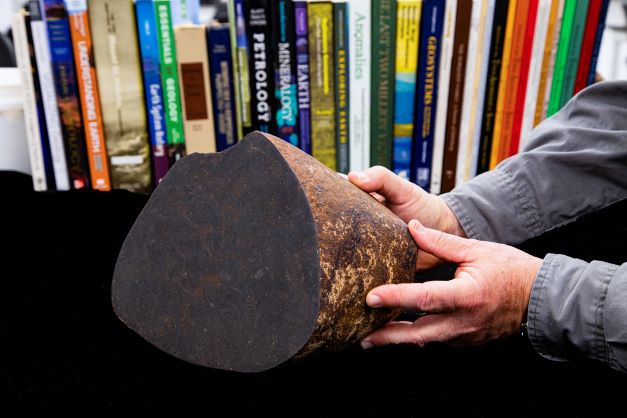La Villa Meteorite

This is the oldest item that dates back to 4.6 billion years ago (4.6 BYA) with the formation of our solar system - and it fell to earth approximately 6,000 - 7,000 years ago (6,000 - 7,000 years BP)
In keeping with the chronological organization of our Ancient Landscapes of South Texas project, here we present a 4.5 billion-year-old object found in April 1956 2.3 miles south-east of La Villa in Hidalgo County, Texas.
With an original mass of 19.8 kg (43.65 lbs), this meteorite was found by a farmer while plowing his field. The piece is rounded and ellipsoidal in shape, with one fairly flat surface, indicating that it probably broke during entry into the earth's atmosphere. It has no outstanding features or pittings, only a 3 mm thick hydrated ferric oxide crust.
Geochemical analysis of a rounded, and suspiciously heavy 44-pound rock, found in 1956 by a farmer plowing a field a few miles from La Villa in Hidalgo County revealed it as an ordinary chondrite, a major class of stony meteorite with more than 90% iron.
The meteorite’s age is estimated to be 4.5 billion years, having formed at the beginning of our solar system. While this makes it the oldest object in south Texas, the estimated timing of its landing makes it one of the most recent geological objects to arrive there! The meteorite has only a thin iron oxide crust from normal weathering and was found near the surface, not deeply buried. Both factors suggest it probably fell within the last seven-thousand years. If it arrived at night, there is chance that prehistoric inhabitants of the Rio Grande Valley witnessed the fireball it produced as it went through the atmosphere.
The meteorite is part of the exhibit at the UTRGV HEB planetarium.
The La Villa is one of 313 formally recognized meteorites from Texas, and one of 1868 meteorites from the United States.
Listen to the English Podcast of the La Villa Meteorite
El análisis geoquímico de una piedra de formas redondeadas y con una masa sospechosamente superior a los 20 kilogramos reveló que este fragmento hallado por un agricultor mientras araba un campo a unos pocos kilómetros de distancia de la localidad de la Villa, en el Condado de Hidalgo, no era sino un condrito común. Se trata de un tipo de meteorito rocoso con un contenido de hierro superior al 90%, de 4 500 millones de años de antigüedad, en los orígenes de nuestro sistema solar. Si bien esta circunstancia lo convierte en el objeto más antiguo del Sur de Texas, debido al momento de su entrada en la Tierra es también uno de los ejemplares geológicos de aparición más reciente. El meteorito apenas tiene una fina capa de óxido de hierro en su superficie debida a la exposición al clima y fue encontrado cerca de la superficie, y no enterrado a gran profundidad. Ambos factores sugieren que probablemente cayera en los últimos 7 000 años. Si su entrada en la atmósfera hubiera tenido lugar durante la noche, se hubiera dado la posibilidad de que los habitantes prehistóricos de El Valle del Río Grande hubieran presenciado una fugaz y deslumbrante estela de luz. En la actualidad, el meteoro forma parte de la colección del Planetario HEB de UTRGV.
Escucha en Espanol - Meteorite de La Villa
